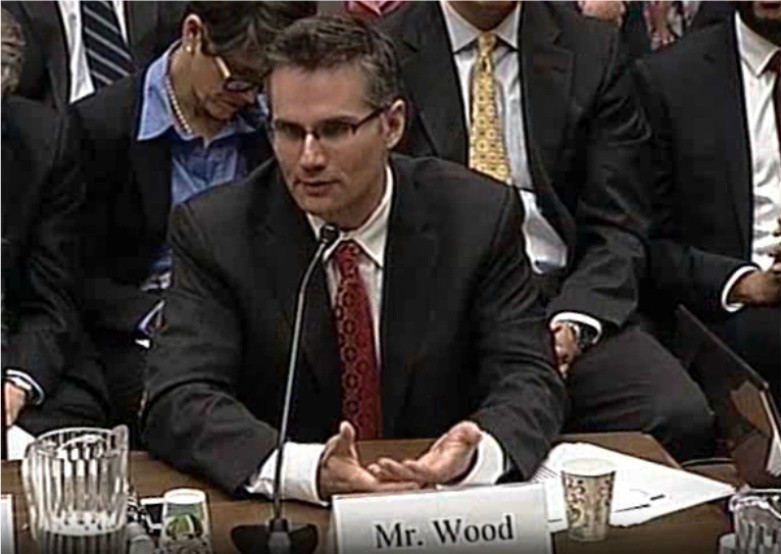
Free Press Action Fund's Matt Wood Urges Congress and the FCC to Stop Broadcasters' Shenanigans
A couple of weeks ago, Free Press Action Fund Policy Director Matt Wood testified before the Senate about competition — or rather, the glaring lack thereof — in the wireless market.
He was back on Capitol Hill today — this time, in the House of Representatives, where he testified about the sneaky tactics broadcasters use to dodge federal ownership rules and gobble up more stations.
For the last several years, companies like Gannett and the Sinclair Broadcast Group have used outsourcing arrangements and shell companies to grow their empires and control multiple TV stations in the same market. In many cases, this means the same cookie-cutter newscast airs on all of the stations in a given community.
To watch the full hearing, click here.
Matt Wood’s full testimony follows below:
Chairman Walden, Ranking Member Eshoo and members of the Subcommittee: Thank you for inviting me to testify today.
My name is Matt Wood. I’m policy director for Free Press, a nonpartisan organization with more than 700,000 members across the country.
Free Press works for policies that promote competing sources of news and journalism, because they’re so important for informing our nation’s democracy and powering our economy.
Unfortunately, the Discussion Draft could contribute to the ongoing loss of such competition. My testimony focuses on Section 4 of that draft, which would keep the FCC from addressing undue media concentration and removing entry barriers for new broadcast businesses.
I will also talk briefly about Section 6, which would keep the agency from following Congress’ direction to increase the choices that people have for set-top boxes and other video devices.
Our media should reflect the full range of experiences and ideas this country has to offer.
It’s essential to see different viewpoints and hear different voices on the dial, even if they don’t always agree — or rather, because they don’t agree. Robust debate and in-depth coverage keep our republic strong and free.
This applies at the national level and at the local level too, where broadcasting remains a vital source of information about our government and our culture.
Television remains the dominant way that Americans get news. Seven in ten people in the U.S. watch local TV news — almost double the number who watch cable news or get news online. But what kind of news are they getting?
The answer for too many Americans is that they get two or more local newscasts produced by the same company.
Sometimes this outsourced news comes from separate news teams. More often, stations have the same reporters, air the same stories, or use the same scripts on two or more channels.
In either case, it’s the same owner calling the shots.
Some broadcasters say this type of “sharing” keeps multiple newscasts on the air. They claim, oddly enough, that the only way to have competing news is for stations to stop competing.
Let’s be clear: When you hear about “synergies” that make news more attractive to produce, there are just two ways to save money: cutting overhead and cutting jobs.
So one person’s “efficiency” is another’s unemployment. And that’s a hardship that affects us all when the people losing their jobs are journalists we depend on to dig into the facts.
Slashing newsroom jobs can happen slowly, as a broadcaster like Sinclair reduced its average number of employees by more than 20 percent, from 55 per station in 2001 to just 43 today.
Or it can be tonight’s top story. In late 2010, the anchor at KMSB in Tucson took to the air and reported the layoffs that hit him and 50 of his colleagues.
What makes it worse is this runaway consolidation happened right in front of the FCC for years, clearly violating its ownership limits.
Section 4 of the draft refers to the “local television multiple ownership rule,” which permits direct or indirect control of more than one station per market only under certain circumstances.
Yet in more than 100 markets — almost half of the TV markets in the whole country — broadcasters use outsourcing arrangements to violate the letter and the spirit of this FCC safeguard.
They do this with Joint Sales Agreements (or “JSAs”), Shared Services Agreements, and a litany of others. Combined, these management agreements transfer control — and the bulk of the affected station’s revenues — away from the supposed licensee.
These outsourcing deals often prop up shell companies that take away opportunities for competing businesses. As a rule, the FCC shouldn’t stand for them.
Last month, the Department of Justice told the FCC that such covert consolidation can harm competition.
Last week, FCC Chairman Tom Wheeler called for a vote to treat JSAs above a certain threshold as what they are: signs of ownership by the broadcasters who really run these stations.
That would align the FCC with the Securities and Exchange Commission, which doesn’t fall for the fiction that these are independent owners. Investors get the truth, and operating stations must treat their so-called “sidecar” companies as subsidiaries.
Even that nickname — “sidecar” company — shows how much they’re driven by conglomerates like Gannett, Nexstar, Raycom, Sinclair, and Tribune.
Section 4 could keep the FCC from moving ahead with its plans to clean up this practice and prevent unlawful transfers of control.
Section 6 also could reduce choices for viewers. As Mr. Zinn explained, the integration ban promotes competition for set-top boxes, which incumbents now charge you up to 20 dollars a month to rent.
Cable customers should be free to take that offer, but they should have options too. And they shouldn’t believe cable claims that blocking innovation by others is itself a form of innovation.
Thank you very much, and I look forward to your questions.